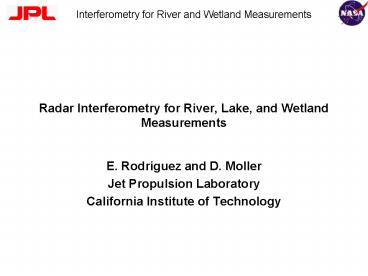Radar Interferometry for River, Lake, and Wetland Measurements - PowerPoint PPT Presentation
1 / 12
Title:
Radar Interferometry for River, Lake, and Wetland Measurements
Description:
It is a high resolution imager. River width, wetland/lake extent ... Instrument Lesson: a high resolution instrument for river and wetland mapping ... – PowerPoint PPT presentation
Number of Views:89
Avg rating:3.0/5.0
Title: Radar Interferometry for River, Lake, and Wetland Measurements
1
Radar Interferometry for River, Lake, and Wetland
Measurements
- E. Rodriguez and D. Moller
- Jet Propulsion Laboratory
- California Institute of Technology
2
What does the ideal instrument look like?
- It is a high resolution imager
- River width, wetland/lake extent
- It has centimetric height accuracy
- River discharge, wetland/lake storage change
- It can measure slopes to mrads
- River discharge
- It measures surface velocity to cm/s
- River discharge
- It has global coverage, sampling all major
contributors to surface water, is not affected by
clouds - Wetlands, rivers, lakes
- It has a repeat period of at most a few weeks
- It can differentiate vegetated vs non-vegetated
- Wetland mapping
- It is cheap and technologically ready
- Well 7/8 88 B
3
How Many Targets Need To Be Imaged?A Lake
Monitoring Example
- Lake size data derived from GSHHS data base
(Wessel, P., and W. H. F. Smith, A Global
Self-consistent, Hierarchical, High-resolution
Shoreline Database, J. Geophys. Res., 101, B4,
pp. 8741-8743, 1996.) - http//www.ngdc.noaa.gov/mgg/shorelines/gshhs.html
- Data compiled from WVS (World Vector Shoreline)
and CIA WDB II data bases. - Smallest lake in data base has an area of 0.1
km2
4
How Much of the Earth Need be Mapped?
- Mapping 99.9 of all lakes requires imaging of lt
10,000 lakes - The total area to be mapped lt 0.5 of the
Earths area - For wetlands, area lt 6 of land, or lt 2.4 of the
Earths area - Instrument Lesson a high resolution instrument
for river and wetland mapping does not have to
have high total data volume - Low average power Low data rate --gt Reduced
relative to global imager
5
Cross-Track Interferometry for Lake Level
Monitoring
5m
10 m
System Characteristics
- Heritage SRTM, WSOA. Rain radar IIP
- Critical Technology Items
- Active antenna
- No scanning required
- Assumption only relevant data collected to
reduce data rate
- Orbit 800 km polar orbit
- Repeat Period 10-20 days
- Baseline 10 m Antenna 5m
- Frequency 35 GHz
- Spatial resolution 2.5 m
6
Interferometric Measurement Concept
- Conventional altimetry measures a single range
and assumes the return is from the nadir point - For swath coverage, additional information about
the incidence angle is required to geolocate - Interferometry is basically triangulation
- Baseline B forms base (mechanically stable)
- One side, the range, is determined by the system
timing accuracy - The difference between two sides (Dr) is obtained
from the phase difference (F) between the two
radar channels.
F 2p D r/l 2pB sin Q/l h H - r sin Q
7
Height Measurement Precision for Lakes and
Wetlands
8
Height Slope Measurement Precision for Rivers
1 mrad 1 cm / 10 km
9
Baseline Roll Error
- dh r sin Q d Q
- An error in the baseline roll angle tilts the
surface by the same angle. - As an order of magnitude, a 10mrad roll error
produces a 2.1 m height error at the footprint - Roll knowledge error sources
- Errors in spacecraft roll estimate
- Mechanical distortion of the baseline (can be
made negligible if the baseline is rigid enough) - Roll errors must be calibrated using existing
DEMs (SRTM)
10
Calibration Using Existing DEMs
- Calibrate data by estimating roll angle which
will reduce rms height difference with existing
DEM (SRTM?) or set of GCPs - Improved DEM can be constructed by merging the
interferometer data collected from multiple
passes - Error reduction by N(-1/2)
- There will be an error! But the error will be
consistent for observations taken at different
times - Change in storage (lakes, wetlands) or discharge
(rivers) is the best that can be obtained from
remote sensing (reservoir and river depths are
not known!) - A 1m DEM average error will result in a 5mrad
slope error.
11
River Velocity Width Slope Measurements
Measure -Doppler Velocity
Measure Topography
Example of measurement of the radial component of
surface velocity using along-track interferometry
Measure Doppler Velocity
12
Combined Cross and Vector Along-Track
Interferometry
- By forming 3 beams/antenna it is possible to
implement an along-track interferometer with
the same instrument configuration as a
cross-track interferometer - Data rate increases by a factor of 3
- Antenna technology must be demonstrated
- Estimated velocity accuracy 2cm/s for 100m x
100m area (improves linearly with averaging area)































